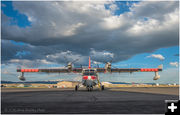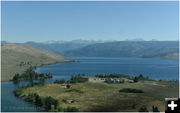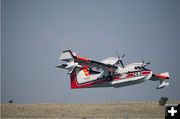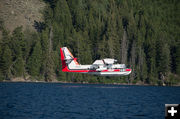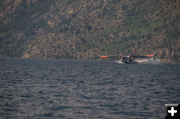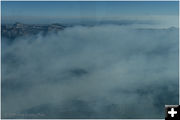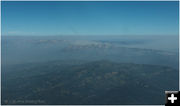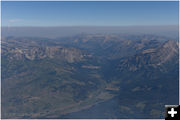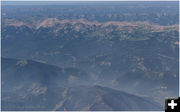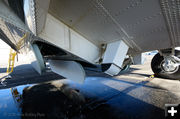

Coming in
Coming in from the West turning right lining up with the length of the lake.
|
|
Incredible Men and their Flying Machines
by Arnie Brokling
July 28, 2016
Frustrated by all the Gloom and Doom being reported about the recent Cliff Creek fire, I set out to document the positive side of this tragedy. I started out at the airport and was immediately fascinated by the variety of equipment staged on our local airfield. There were three huge helicopters, all from different contractors, and a large team to support each one of them. Fuel trucks, mechanics, supervisors, and of course the flight staff.
Another part of the arsenal that looked much different than the old antiquated helicopters, were what looked like, two shiny new airplanes. These were not ordinary planes retrofitted to fight wildfire but state of the art, built for purpose firefighting aircraft. Only two of these machines are currently in service in the United States and they are both deployed here in Sublette County.
At a cost of $33 million each, these firefighting marvels of engineering are capable of 200 knots plus air speeds, load 1600 gallons of water in 12 seconds, climb out fully loaded at 1200 feet per minute and drop their load in one second with pinpoint accuracy. They can keep working for 3 Ĺ hours before refueling. Although not cheap to operate, they can move more water than any other aircraft.
Not only are the performance specs impressive, the caliber of people working on them are exceptional as well. Fire conditions (smoke) were not ideal for aerial combat, so I was fortunate enough to get to know some of the team. Each plane owned by Aeroflite, are staffed with two pilots, two mechanics and other support team members shared by the other plane. When not dispatched, this support team is busy with routine maintenance. Whether itís service required by air hours or just keeping things looking good and at the ready, it was very apparent that they all took immense pride in their work. One of the planes was brand new, this was its first fire, the older plane looked just like it, perfect! After returning from each mission, the planes go through a visual inspection, through wipe down, critical fluids checked, water tanks decontaminated for Aquatic Invasive Species, refueled and readied for dispatch. The crew has no set hours, they are ready to do what is needed when the airplanes return. Looking at these planes and watching these crews in action is awe inspiring!
I was lucky enough to get a few photographs of what a "Scooping Mission" is like:
The plane took off from the Pinedale airport and made a steep banked turn to the right lining up with Pine Creek and heading directly up Fremont Lake. The numbers on the digital altimeter, just a blur verifying a quick descent.
At the last second, the plane flares out level, touches the lake as both water scoops are commanded out. The drag of the scoops noticeable, the pilot throttles up the aircraft in preparation for the climb. Twelve seconds later, both 800 gallon tanks indicating full, the scoops are retracted, the reduced drag is felt and the aircraft begins to accelerate to the required take off speed. Suddenly the sound of water vanishes and the altimeter indicates a 1200 ft/min climb.
Although the twin 2300 horsepower turboprops are plenty of trigger for the job at hand, they labor a bit more at the 8000 foot elevation of our mountain lake. Now clear of Fremont Ridge, the Bombadier 415 "Super Scooper" banks left and heads for the fire.
The pilot receives instruction and instantly makes a steep descent en route to his target, just as quickly the 1600 gallons or 13,000 pounds of water is dumped on target. The plane now feels noticeably lighter as it easily climbs out and away from the fire and heads back to the lake for another load.
This cycle only takes 20 minutes and will be repeated 8 times before heading back to Ralph Wenz field for the night. These truly are incredible men and flying machines!
The plane softly touches down and the exhausted crew taxisto the waiting support team. Once again, they meticulously go through the aircraft, doing what they do and loving it. After everything is refueled, inspected and cleaned, these two amazing birds are put down for the night.
This story was written using a combination of online research, time spent with the actual flight crew, visual observation and a little bit of imagination. Iíve done my best to tell the story as close to reality as possible. All photography is copyright of Arnie Brokling Photo. A special thanks to Jim McLellan who made the simulated "Scooper" flight possible. Note that the original story was based on Scooping operations on July 19th and the aerial flight path simulation photographs taken on July 23rd.
|
